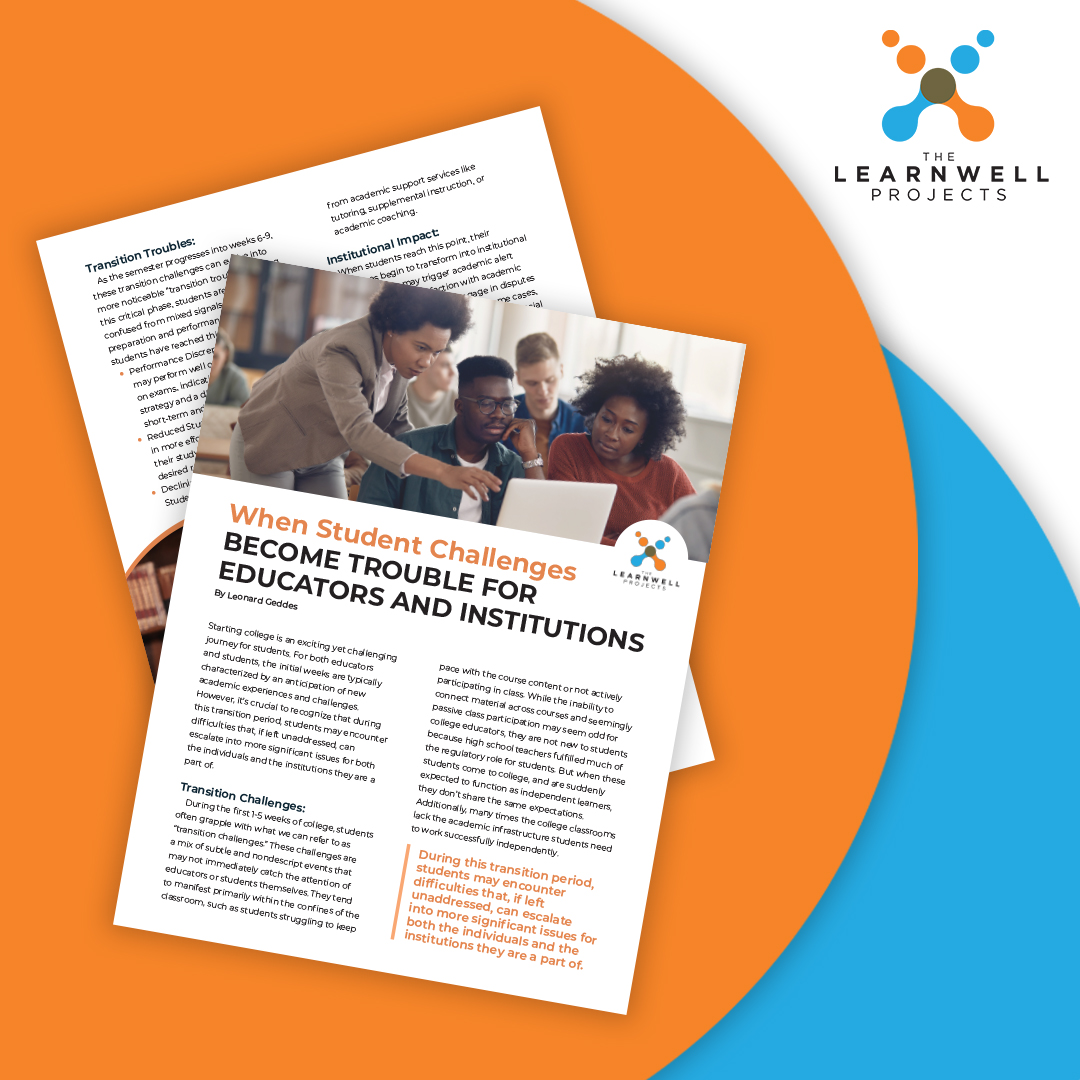Starting college is an exciting yet challenging journey for students. For both educators and students, the initial weeks are typically characterized by an anticipation of new academic experiences and challenges. However, it’s crucial to recognize that during this transition period, students may encounter difficulties that, if left unaddressed, can escalate into more significant issues for both the individuals and the institutions they are a part of.
Transition Challenges:
During the first 1-5 weeks of college, students often grapple with what we can refer to as “transition challenges.” These challenges are a mix of subtle and nondescript events that may not immediately catch the attention of educators or students themselves. They tend to manifest primarily within the confines of the classroom, such as students struggling to keep pace with the course content or not actively participating in class. While the inability to connect material across courses and seemingly passive class participation may seem odd for college educators, they are not new to students because high school teachers fulfilled much of the regulatory role for students. But when these students come to college, and are suddenly expected to function as independent learners, they don’t share the same expectations. Additionally, many times the college classrooms lack the academic infrastructure students need to work successfully independently.
Transition Troubles:
As the semester progresses into weeks 6-9, these transition challenges can evolve into more noticeable “transition troubles.” During this critical phase, students are likely to get confused from mixed signals regarding their preparation and performance. Indicators that students have reached this stage include:
- Performance Discrepancies: Students may perform well on quizzes but struggle on exams, indicating a lack of a coherent strategy and a disconnect between their short-term and long-term learning tactics.
- Reduced Study Efficacy: Despite putting in more effort, students may find that their study methods are not yielding the desired results.
- Declining Academic Assistance Benefits: Students may start to derive less benefit from academic support services like tutoring, supplemental instruction, or academic coaching.
Institutional Impact:
When students reach this point, their challenges begin to transform into institutional problems. They may trigger academic alert systems, voice dissatisfaction with academic assistance services, or even engage in disputes with faculty members. In some extreme cases, students may resort to public protests or social media campaigns against their institutions. As an example of how heated these situations can become, I sat in on a focus group of disgruntled students in the spring of 2021 who were leading a public revolt against their institution. At the core of the students’ problem, were strong feelings of frustration and despair about their performance and prospects of academic success. These feelings were directly attributable to transition traps, which were confusing students and damaging teacher-student relationships. Having exhausted their methods to improve their performance, the students were actively acting out against their teachers and administrators.
The Missed Opportunity:
One lamentable aspect of this situation is that with timely intervention earlier in the semester, many of these issues could have been prevented. By dealing with the transition traps that lurk throughout our environments, we can empower students to seamlessly and successfully transition into college-level work and achieve better academic outcomes.
Summary and Looking Ahead:
In summary, the transition from high school to college is a critical period during which students encounter challenges that, if unaddressed, can escalate into significant issues for both individuals and institutions. In the early stage (weeks 1-5), the challenges that eventually lead to traps may go unnoticed. But in the second stage (weeks 6-9), students are clearly in trouble. I’ve listed some indicators you can use to detect students who are stuck in transition trouble.
In my next article, I will share what’s behind the anger and apathy that many students experience during the final weeks (weeks 10-15) of the semester. Moreover, I’ll share strategies to replace these negative emotions with positive ones, ultimately fostering a learning environment where students feel competent and confident in their academic pursuits. This proactive approach can lead to improved student performance and overall satisfaction, benefiting both students, educators and institutions.
You can use the following reflective questions to enrich educators and students figure out whether transition troubles are hindering academic success.
For Students:
- Performance Discrepancies: Do you perform better on quizzes than on tests? If “yes,” then your study methods are producing superficial outcomes rather than the more meaningful course knowledge.
- Reduced Study Efficacy: Have you noticed that despite putting in more effort, your study methods are not yielding the desired results? If “yes,” then you should start using your course learning outcomes as learning metrics, as opposed to the amount of time you spend studying.
- Declining Academic Assistance Benefits: Are academic support services like tutoring or coaching not helping you enough? These services will be less effective if you are still caught in transition traps. You must learn how to strategically use your thinking skills. You can learn more about this threshold academic skill by viewing my Differentiating Thinking Skills video at the following YouTube link: https://bit.ly/diff-thinking-skills.
For Teachers:
- Performance Discrepancies: Do your students tend to perform better on low-stakes assessments than high-stakes assessments? If so, then this discrepancy suggests that students are learning the daily content covered in class without connecting it to the broader course concepts. Students can benefit from learning ways to engage in macrolabor practices, as I introduced in a previous article: https://bit.ly/macrolabor.
- Reduced Study Efficacy: Do students complain that their studying does not improve their grades? If so, then they are likely conflating effective work with “pseudowork,” and it not only frustrates them but burdens you as well. You can learn how to resolve this conundrum in my forthcoming book: How to Successfully Transition Students into College: From Traps to Triumph, at www.transitiontraps.com.
- Declining Academic Assistance Benefits: Have measures such as embedded tutors, academic coaches or supplemental instruction not moved the needle as much as you would have liked? Without the proper academic infrastructure in place, such as metacognitive-based learning outcomes, then these activities just give students more to do without the expected benefits. I present The Academic Formula that teachers and learning assistant peers and professionals can use as a guide to ensure students are interacting properly with the course content.
Leave a thoughtful comment below and I’ll send you a PDF version of this article to share with your network.



Your timing with this article was perfect! I appreciate having the questions to ask as students work on figuring out what isn’t working for them… Thank you!
Important work here! While students transitioning into new academic environments is not new, what I find “new” is faculty/administrators lack of engagement with the process. I think with all the changes education has gone thru in the past few years, educators are tired and many lack the enthusiasm needed to welcome our new incoming students. I appreciate the questions your article has for both students and educators.
One thing that I constantly try to remind myself and other educators, when these kinds of discussions arise, is that students who arrive at college are NOT college students. They are new participants learning to BE college students. I used to keep the same in mind for K-12 educating. When my high school freshmen arrived, I had to remember that they were really 8th graders showing up with the hopes of becoming successful high school students.
We are aware, and even mark, each benchmark in a child’s first few years of life; however, we are all moving in the direction of growth (hopefully) and need benchmarks to help us know when we have arrived.
Great perspective Tracy. One phrase I try to keep in mind is from a colleague who was very successful with first-year students. At the start of each academic year, he say, “Ah, the college freshman, four year removed from middle school and four years removed from adulthood.”
Thank you for providing concrete questions to identify struggling students and specific suggestions for addressing each issue. Working with numerous struggling student sometimes overwhelms me and it’s hard to know where to start!
Hi Lynn,
Thanks for your comment. I’ll send the PDF article over to you. Please share how your students respond to the questions.
When reading this article, I immediately thought of a faculty member who was complaining just today about students who seem apathetic and who are not taking advantage of tutoring resources.
Hi Mary,
Thanks for your comment. I’ll send the PDF article over to you. It should bring clarity and help faculty and students work together to end the semester on a high note!
Quite inciteful.
This article is very informative and on point.